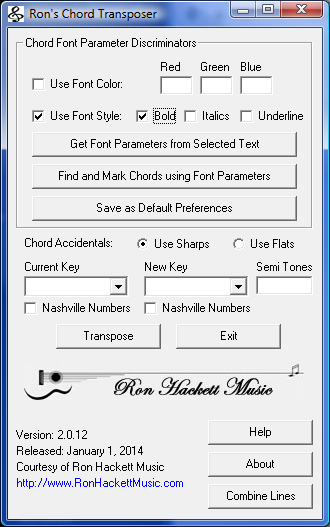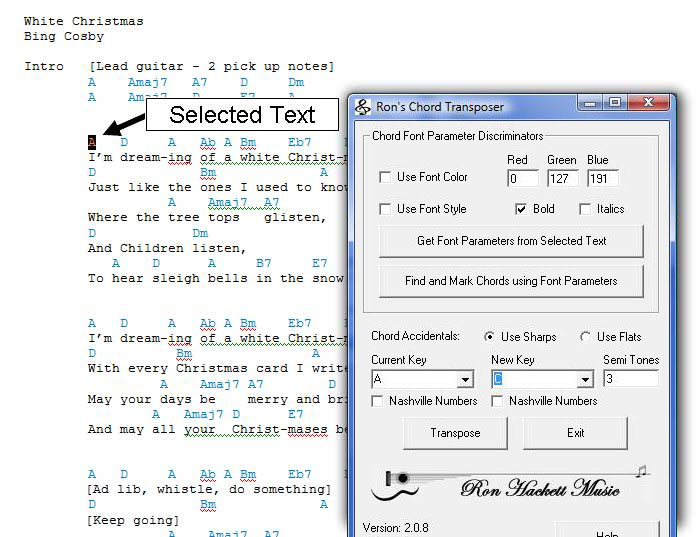Tips & Resources for Musicians

Ron's Chord Transposer for Microsoft Word, Version 2.0
 Ron's Chord Transposer for Microsoft Word is a free application courtesy of Ron Hackett Music. You are free to use and share this program as long as you do not modify it, and you give adequate credit and attribution to Ron Hackett Music.
Ron's Chord Transposer for Microsoft Word is a free application courtesy of Ron Hackett Music. You are free to use and share this program as long as you do not modify it, and you give adequate credit and attribution to Ron Hackett Music.What is Transposer?
Transposer is an application that works with Microsoft Word 2003 and later to transpose text based chord charts with or without lyrics into different keys. Transposer works by using font parameters, like color, bold, and italics, to determine which text is a legitimate chord symbol. Version 2.0 adds a chord search feature that can find and set the font parameters in your chart. This feature does not find Nashville Number System chords. You can also set the font parameter for an entire line at a time, so it shouldn't take long to add a definitive font discriminator to your chord sheet. See our hints section for suggestions on adding discriminators.
If you like Transposer and find it useful, please send me an email. I'd love to hear from you, and it would encourage me to write other useful programs for musicians. Your suggestions are appreciated. I got the idea for Transposer when I was helping our music minister prepare for our Christmas program. We had worked out our arrangements, but needed to transpose them to work with different singers. As a computer programmer and a musician, Ron's Chord Transposer was a joy to write. I hope you find it useful.
If you like Transposer and find it useful, please send me an email. I'd love to hear from you, and it would encourage me to write other useful programs for musicians. Your suggestions are appreciated. I got the idea for Transposer when I was helping our music minister prepare for our Christmas program. We had worked out our arrangements, but needed to transpose them to work with different singers. As a computer programmer and a musician, Ron's Chord Transposer was a joy to write. I hope you find it useful.
Downloading Transposer
Click here to download the Ron's Chord Transposer for Microsoft Word set-up program
Installing Transposer
Just run the setup program that you downloaded.
Starting Transposer
The setup program gives you the option of creating a desktop icon and a link in the Start menu. Just click on one of these links to start Ron's Chord Transposer, just like you would start any other program. Microsoft Word is required. If Microsoft Word is not installed, then the program will fail. You do not have to open your chord chart document before you start Ron's Chord Transposer. It works with the currently active document.
Using Transposer
We highly recommend that you make a back up copy of your chord chart. There is no standard for constructing a chord chart, and your construction may not work well with Transposer. We have endeavored to make our program compatible with all of the chord charting examples that we have seen, but that doesn't mean we've considered everything that is available.

1. If your chord chart document already uses a distinctive font for the chords, then select an example of a chord symbol and click the "Get Font Parameters from Selected Text" button as shown above. Selecting a single character works best. If Transposer can't determine the font color, then you will be warned. Here we see that the chord font color for this chart has an RGB value of 0 127 191. If the chords are not already marked with a font parameter, then you can use the "Find and Mark chords using Font Parameters" button to locate and mark chords. You have to tell the program what Font Parameters you want to use before you can use this feature. This feature does not yet find chords using the Nashville Number System.
2. Check the appropriate boxes to use the font color and/or the font style as a chord symbol discriminator. In this example, we would select "Use font color" as our discriminator. Without a chord font discriminator, Transposer would transpose all capital letters from A to G. In this example, the word Christmas in our title and our lyrics would become "D#ristmas."
3. Select whether you want to use sharps or flats for accidentals. The default is sharps. Yes, there is a standard convention, but some musicians prefer not to follow the tradition. That's why I opted to select sharps or flats instead of major or minor keys.
4. Select the current key and the new key. It doesn't matter whether it is minor or major. For example, it doesn't matter whether you are in E major or E minor, just select E in the drop down list. If you want to convert to or from Nashville Numbers, then check the appropriate box.
5. Click the Transpose button. When the transposition is complete, the Current Key selection will be the same as the New Key.

1. If your chord chart document already uses a distinctive font for the chords, then select an example of a chord symbol and click the "Get Font Parameters from Selected Text" button as shown above. Selecting a single character works best. If Transposer can't determine the font color, then you will be warned. Here we see that the chord font color for this chart has an RGB value of 0 127 191. If the chords are not already marked with a font parameter, then you can use the "Find and Mark chords using Font Parameters" button to locate and mark chords. You have to tell the program what Font Parameters you want to use before you can use this feature. This feature does not yet find chords using the Nashville Number System.
2. Check the appropriate boxes to use the font color and/or the font style as a chord symbol discriminator. In this example, we would select "Use font color" as our discriminator. Without a chord font discriminator, Transposer would transpose all capital letters from A to G. In this example, the word Christmas in our title and our lyrics would become "D#ristmas."
3. Select whether you want to use sharps or flats for accidentals. The default is sharps. Yes, there is a standard convention, but some musicians prefer not to follow the tradition. That's why I opted to select sharps or flats instead of major or minor keys.
4. Select the current key and the new key. It doesn't matter whether it is minor or major. For example, it doesn't matter whether you are in E major or E minor, just select E in the drop down list. If you want to convert to or from Nashville Numbers, then check the appropriate box.
5. Click the Transpose button. When the transposition is complete, the Current Key selection will be the same as the New Key.
Reporting Bugs
I did my best to anticipate the needs of most musicians, but I may have overlooked something. Please help everyone by reporting bugs by sending me an email. Please include as much information as possible about the problem and a sample of the chord text that does not transpose properly.
Helpful Suggestions
• To transpose a section rather than the entire page, copy the section to a temporary document, transpose
it and copy it back to the original document
• You can switch from using sharps to flats and vice versa by transposing to the same key and changing the accidentals setting. I've worked with musicians that wanted to see sharps even though the tradition for that key was to use flats.
• A quick way to add discriminators is with keyboard shortcuts. With the cursor at the beginning of a line that you want to select, hold the shift key and press the down arrow. Make the changes that you want to the chord fonts and then press the down arrow without the shift key to move down to the next line that you want to select. Control-B will bold the selected font, and control-I will set the font to Italics. Repeat this process until all chord fonts have a font parameter that is different from lyrics and other no chord items in your document.
• You can switch from using sharps to flats and vice versa by transposing to the same key and changing the accidentals setting. I've worked with musicians that wanted to see sharps even though the tradition for that key was to use flats.
• A quick way to add discriminators is with keyboard shortcuts. With the cursor at the beginning of a line that you want to select, hold the shift key and press the down arrow. Make the changes that you want to the chord fonts and then press the down arrow without the shift key to move down to the next line that you want to select. Control-B will bold the selected font, and control-I will set the font to Italics. Repeat this process until all chord fonts have a font parameter that is different from lyrics and other no chord items in your document.








